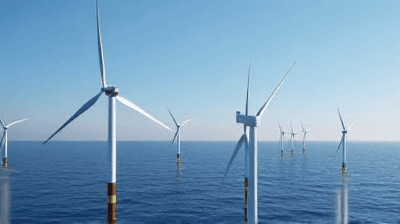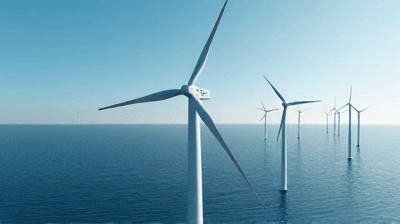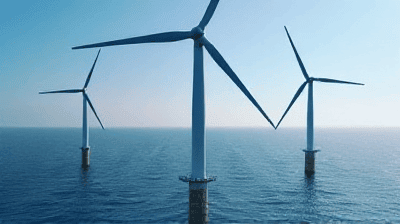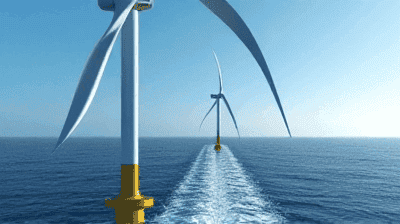
As the world grapples with the urgent need to combat climate change, the transition to renewable energy sources has never been more crucial. Among the various solutions available, offshore wind farms have emerged as a game-changer in clean energy production. Harnessing the power of wind over open waters, these installations offer immense potential for generating sustainable electricity.
Offshore wind farms consist of multiple wind turbines installed in bodies of water, typically on the continental shelf, to capture wind energy that is stronger and more consistent than that found on land. These farms can be located in shallow waters (up to 60 meters deep) or in deeper waters using floating turbine technology.
The basic operation of offshore wind farms involves several processes:
Energy Capture: Wind turbines convert kinetic energy from the wind into mechanical energy, which is then transformed into electrical energy through a generator.
Transmission: The generated electricity is sent through underwater cables to shore, where it connects to the grid for distribution.
Monitoring and Maintenance: Offshore wind farms are equipped with advanced monitoring systems to ensure optimal performance and timely maintenance, given the unique environmental challenges they face.
Offshore wind farms offer numerous advantages that contribute to their growing popularity:
Stronger Wind Resources: Wind speeds over open water tend to be higher and more consistent than those experienced on land, resulting in increased energy generation.
Less Land Competition: Offshore installations do not compete for land use, eliminating conflicts with agriculture, habitation, or other land-based activities.
Environmental Benefits: Offshore wind farms produce no greenhouse gas emissions during operation, contributing significantly to climate change mitigation efforts.
Job Creation: The development and maintenance of offshore wind farms generate employment in various sectors, including engineering, construction, and operations.
Energy Security: By diversifying energy sources, offshore wind can enhance energy security and reduce dependence on fossil fuels.

The journey of offshore wind energy began in the late 1990s, with early projects in Denmark paving the way for larger installations. The capacity of offshore wind projects has grown exponentially since then, with advances in technology and decreasing costs making them a more attractive energy source.
As of 2023, several countries have made significant investments in offshore wind energy:
United Kingdom: The UK is a leader in offshore wind capacity, with projects like the Hornsea One wind farm, which is currently the largest in the world.
Germany: Germany has also made substantial investments, particularly in the North Sea, driving the growth of its renewable energy sector.
United States: While the U.S. has lagged behind in offshore wind development, recent initiatives, particularly along the East Coast, signal a growing commitment to harnessing this energy source.
China: China has rapidly expanded its offshore wind capacity in recent years, representing a significant portion of the global market.
Larger Turbines: Modern offshore wind turbines are significantly larger than their predecessors, with some reaching over 12 MW in capacity. Larger turbines can capture more wind energy and generate more electricity per unit.
Floating Offshore Wind Technology: Floating platforms allow wind turbines to be installed in deeper waters (more than 60 meters), where traditional fixed-bottom installations are not feasible. This technology opens up vast new areas for wind energy development.
Enhanced Rotor Designs: Innovations in blade design, including longer and more aerodynamically efficient blades, enable turbines to capture more energy from the wind, increasing their overall efficiency.
Battery Technology: Advances in battery storage technology are being integrated into offshore wind projects to store excess energy produced during peak production for later use.
Smart Grids: Developing smart grid technology is crucial for effectively managing the variable output of offshore wind farms, ensuring that generated energy can be efficiently distributed based on demand.
Advanced Sensors and Drones: The use of drones and sensors for environmental monitoring helps assess the impact of offshore wind farms on marine life and ecosystems. This technology ensures compliance with environmental regulations and aids in mitigating potential impacts.
Modeling and Simulation: Improved modeling tools enable precise predictions of how wind farms will interact with the environment, allowing for better planning and design.

Installation Costs: The initial capital costs for offshore wind projects can be high due to the complexities of installation in marine environments. However, these costs have decreased significantly over the past decade as technology has advanced and installation techniques have improved.
Levelized Cost of Energy (LCOE): Despite higher initial costs, the LCOE of offshore wind has become competitive with traditional energy sources. As new projects are commissioned, ongoing cost reductions are expected to continue.
Subsidies and Tax Credits: Many governments offer financial incentives to support offshore wind development, including tax credits, grants, and guaranteed pricing mechanisms.
Renewable Energy Targets: Mandates and commitments to shift toward renewable energy sources inspire investments in offshore wind, encouraging long-term planning and project development.
Direct Employment: The development and maintenance of offshore wind farms create thousands of jobs, from skilled labor in construction to engineering and project management.
Supply Chain Opportunities: The growth of the offshore wind industry stimulates local economies through the creation of a supply chain for manufacturing components, vessel services, and maintenance.
Marine Ecosystems: Offshore wind farms can affect local marine ecosystems. However, studies suggest that these installations may provide habitats for various marine species, contributing positively to biodiversity.
Bird and Bat Populations: One of the primary concerns is the impact of wind turbines on migratory birds and bats. Mitigation measures, including careful site selection and advanced monitoring, help minimize these impacts.
Reducing Greenhouse Gas Emissions: By displacing fossil fuel generation, offshore wind farms significantly reduce greenhouse gas emissions, aiding global efforts to limit climate change.
Long-Term Sustainability: Offshore wind represents a sustainable and renewable energy source that can be harnessed over the long term, making it a key component of a sustainable energy future.

Harsh Marine Conditions: The marine environment is often harsh, with challenges including saltwater corrosion, strong currents, and extreme weather conditions that can impact the design and maintenance of wind farms.
Installation Logistics: The logistics of transporting materials and equipment to offshore sites are complex and require specialized vessels and labor.
Complex Regulatory Frameworks: Navigating the legal and regulatory landscape can be a significant hurdle for offshore wind projects, with multiple agencies involved in permitting processes.
Stakeholder Engagement: Engaging with local communities, fishermen, environmental organizations, and other stakeholders is essential for project success, but it can also lead to delays and additional requirements.
Competing Energy Sources: Offshore wind must compete with other renewable sources like solar energy and onshore wind, as well as with traditional energy sources that may have a lower LCOE in some regions.
Global Supply Chains: The global nature of the supply chain for offshore wind components can create vulnerabilities, particularly in times of geopolitical tension or trade disputes.
The global offshore wind industry is projected to experience significant growth over the next decade, driven by technological advancements, cost reductions, and increasing demand for renewable energy. Many countries have set ambitious targets for offshore wind capacity, aiming to transition to cleaner energy sources.
Floating Wind Farms: As floating wind technology matures, the potential for larger, deeper water installations will expand access to high-wind areas, increasing the overall capacity for offshore wind generation.
Hybrid Energy Systems: Integrating offshore wind with other renewable energies, such as solar or tidal energy, can create hybrid systems that enhance energy reliability and efficiency.
Digital Technologies: Advancements in digital technologies, including artificial intelligence and machine learning, can optimize wind farm operations and maintenance, improving overall efficiency.
International Partnerships: Collaboration among countries, businesses, and research institutions can drive innovation and knowledge-sharing in the offshore wind sector.
Trade Associations and Alliances: The formation of trade associations and public-private partnerships can promote best practices, advocate for policy support, and address industry challenges.
Offshore wind farms are revolutionizing the landscape of clean energy production, presenting a sustainable and efficient solution to global energy demands. With their ability to harness powerful and consistent winds over the ocean, these installations contribute significantly to reducing greenhouse gas emissions and advancing the fight against climate change.
As technological advancements continue and costs decline, the potential for offshore wind energy is vast. While challenges remain, the benefits of offshore wind—ranging from boosting job creation and economic growth to promoting energy security—underscore its role as a cornerstone of a sustainable energy future. By harnessing the power of offshore wind, we can create a cleaner, greener planet for generations to come.